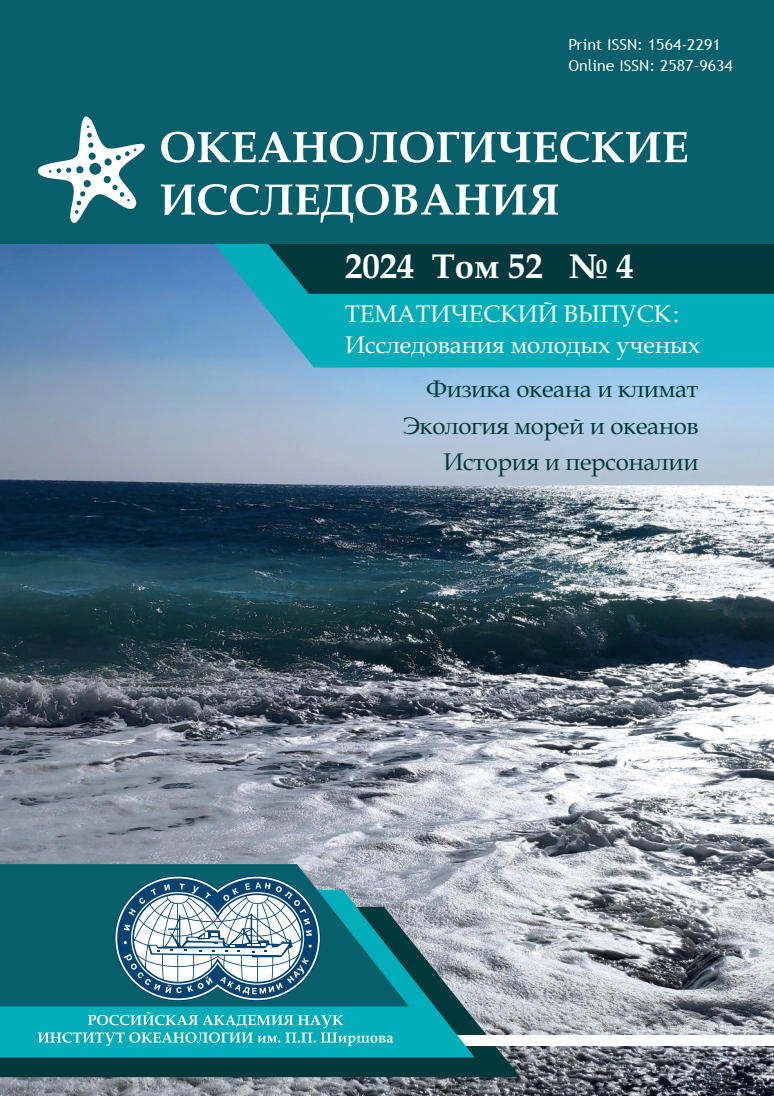BUOYANCY FLUX AS A METRIC FOR OCEAN–ATMOSPHERE INTERACTION ANALYSES ON DIFFERENT TIME SCALES
Abstract
The article provides a comprehensive review of publications, both in journals and monographs, devoted to the metric of ocean–atmosphere interaction – the buoyancy flux. This method of assessing the tendency to vertical mixing in the ocean, derived theoretically in the second half of the XX century, is currently used. The buoyancy flux allows not only a qualitative but also a quantitative assessment of ocean-atmosphere interaction through heat, moisture, and radiative fluxes on different time scales. It can be used to account for the contribution of different components of the ocean-atmosphere interaction to the dynamics of the upper mixed layer of the ocean: radiative fluxes, heat fluxes, and freshwater fluxes. To assess the ability of land bodies to absorb or emit CO2 as a function of synoptic atmospheric dynamics, and even to estimate the variability of upwelling that affects the socio-economic situation in coastal areas. The review summarises scientific papers using buoyancy flux for various purposes, presents the first paper to introduce the metric, and summarises methodologies that offer promise in this line of research based on current ocean and atmospheric data. Forty-two English-language papers and 5 publications by Russian researchers have been analysed.
References
- Anitha, G., M. Ravichandran, and R. Sayanna, 2008: Surface buoyancy flux in Bay of Bengal and Arabian sea. Annales Geophysicae, 26, 184–193, https://doi.org/10.5194/angeo-26-395-2008.
- Bailey, S. T., C. S. Jones, R. P. Abernathey, A. L. Gordon, and X. Yuan, 2023: Water mass transformation variability in the Weddell Sea in ocean reanalyses. Ocean Science, 19 (2), 381–402, https://doi.org/10.5194/os-19-381-2023.
- Baines, P. and C. Folland, 2007: Evidence for a rapid global climate shift across the late 1960s. Journal of Climate, 20 (12), 2721–2744, https://doi.org/10.1175/JCLI4177.1.
- Bashmachnikov, I. L., A. M. Fedorov, P. A. Golubkin, A. V. Vesman, V. V. Selyuzhenok, N. V. Gnatiuk, L. P. Gnatiuk, K. I. Hodges, and D. S. Dukhovskoy, 2021: Mechanisms of interannual variability of deep convection in the Greenland Sea. Deep Sea Research Part I: Oceanographic Research Papers, 174, 103557, https://doi.org/10.1016/j.dsr.2021.103557.
- Biastoch, A., C. W. Böning, J. Getzlaff, J.-M. Molines, and G. Madec, 2008: Causes of Interannual–Decadal Variability in the Meridional Overturning Circulation of the Midlatitude North Atlantic Ocean. Journal of Climate, 21 (24), 6599–6615, https://doi.org/10.1175/2008JCLI2404.1.
- Bjerknes, J., 1969: Atmospheric Teleconnections From the Equatorial Pacific. Monthly Weather Review, 97 (3), 163–172, https://doi.org/10.1175/1520-0493(1969)097<0163:ATFTEP>2.3.CO;2.
- Caneill, R., F. Roquet, G. Madec, and J. Nycander, 2022: The Polar Transition from Alpha to Beta Regions Set by a Surface Buoyancy Flux Inversion. Journal of Physical Oceanography, 52 (8), 1887–1902, https://doi.org/10.1175/JPO-D-21-0295.1.
- Cerovečki, I., L. D. Talley, and M. R. Mazloff, 2011: A Comparison of Southern Ocean Air-Sea Buoyancy Flux from an Ocean State Estimate with Five Other Products. Journal of Climate, 24, 6283–6306, https://doi.org/10.1175/2011JCLI3858.1.
- Chubarenko, I. P., 2010: Gorizontal’nyj konvektivnyj vodoobmen nad podvodnym sklonom: mekhanizm formirovaniya i analiz razvitiya (Horizontal Convective Water Exchange Above A Slopping Bottom: The Mechanism Of Its Formation And An Analysis Of Its Development). Oceanology, 50 (2), 184–193, https://doi.org/10.1134/S0001437010020025.
- Clarke, R. A. and J. C. Gascard, 1983: The formation of Labrador Sea Water. Part I: Large-scale processes. Journal of Physical Oceanography, 13, 1764–1778, https://doi.org/10.1175/1520-0485(1983)013<1764:TFOLSW>2.0.CO;2.
- Cronin, M. F. and J. Sprintall, 2001: Wind and buoyancy-forced upper ocean. Encyclopedia of Ocean Sciences, 3217–3214, https://doi.org/10.1006/rwos.2001.0157.
- Garrett, C., R. Outerbridge, and K. Thompson, 1993: Interannual Variability in Mediterranean Heat and Buoyancy Fluxes. Journal of Climate, 6 (5), 900–910, https://doi.org/10.1175/1520-0442(1993)006<0900:IVIMHA>2.0.CO;2.
- Garrett, C., K. Speer, and E. Tragou, 1995: The Relationship between Water Mass Formation and the Surface Buoyancy Flux, with Application to Phillips’ Red Sea Model. Journal of Physical Oceanography, 25 (7), 1696–1705, https://doi.org/10.1175/1520-0485(1995)025<1696:TRBWMF>2.0.CO;2.
- Gill A. E., 1982: Atmosphere–Ocean Dynamics. Cambridge, Academic Press.
- Golitsyn, G. S., 2008: Uragany, polyarnye i tropicheskiye, ikh energia i razmery, kolichestvenny kritery vozniknovenia (Polar Lows And Tropical Hurricanes: Their Energy And Sizes And Quantitative Criterion For Their Generation). Izvestiya Rossysskoy Akademii Nauk. Phisica Atmosphery i Okeana, 44 (5), 579–590, https://doi.org/10.1134/S0001433808050010.
- Gregory, J. M. et al., 2016: The Flux-Anomaly-Forced Model Intercomparison Project (FAFMIP) contribution to CMIP6: investigation of sea-level and ocean climate change in response to CO2 forcing. Geoscientific Model Development, 9 (11), 3993–4017, https://doi.org/10.5194/gmd-9-3993-2016.
- Gulev, S. K., B. Barnier, H. Knochel, J.-M. Molines, and M. Cottet, 2003: Water Mass Transformation in the North Atlantic and Its Impact on the Meridional Circulation: Insights from an Ocean Model Forced by NCEP–NCAR Reanalysis Surface Fluxes. Journal of climate, 16 (9), 3085–3110, https://doi.org/10.1175/1520-0442(2003)016<3085:WMTITN>2.0.CO;2.
- Gulev, S. K., B. Barnier, J.-M. Molines, T. Penduff, and J. Chanut, 2007: Impact of spatial resolution on simulated surface water mass transformations in the Atlantic. Ocean Modelling, 19, 138–160, http://dx.doi.org/10.1016/j.ocemod.2007.07.004.
- Isachsen, P. E., C. Mauritzen, and H. Svensen, 2007: Dense water formation in the Nordic Seas diagnosed from sea surface buoyancy fluxes. Deep Sea Research. Part I: Oceanographic Research Papers, 54 (1), 22–41, https://doi.org/10.1016/j.dsr.2006.09.008.
- Iudicone, D., G. Madec, and T. J. McDougall, 2008: Water-Mass Transformations in a Neutral Density Framework and the Key Role of Light Penetration. Journal of Physical Oceanography, 38 (7), 1357–1376, https://doi.org/10.1175/2007JPO3464.1.
- Jansen, M. F. and L.-P. Nadeau, 2016: The Effect of Southern Ocean Surface Buoyancy Loss on the Deep-Ocean Circulation and Stratification. Journal of Physical Oceanography, 46 (11), 3455–3470, https://doi.org/10.1175/JPO-D-16-0084.1.
- Kalnay, E. et al., 1996: The NCEP/NCAR 40-Year Reanalysis Project. Bulletin of the American Meteorological Society, 77 (3), 437–472, https://doi.org/10.1175/1520-0477(1996)077%3C0437:TNYRP%3E2.0.CO;2.
- Karstensen, J. and K. Lorbacher, 2011: A. practical indicator for surface ocean heat and freshwater buoyancy fluxes and its application to the NCEP reanalysis data. Tellus A: Dynamic Meteorology and Oceanography, 63A, 338–347, https://doi.org/10.1111/j.1600-0870.2011.00510.x.
- Killworth, P. D., 1983: Deep Convection In The World Ocean. Reviews of Geophysics and Space Physics, 21 (1), 1–26, https://doi.org/10.1029/RG021i001p00001.
- Kostov, Y., H. L. Johnson, and D. P. Marshall, 2019: AMOC sensitivity to surface buoyancy fluxes: the role of air-sea feedback mechanisms. Climate Dynamics, 53, 4521–4537, https://doi.org/10.1007/s00382-019-04802-4.
- Kraus, E. B. and J. A. Businger, 1994: Atmosphere–Ocean Interaction, Second Edition. Oxford, Oxford University Press.
- Large, W. G. and S. G. Yeager, 2009: The global climatology of an interannually varying air-sea flux data set. Climate Dynamics, 33, 341–364, https://ui.adsabs.harvard.edu/link_gateway/2009ClDy...33..341L/doi:10.1007/s00382-008-0441-3.
- Lozier, M. S., 2010: Deconstructing the Conveyor Belt. Science, 328 (5985), 1507–1511, https://doi.org/10.1126/science.1189250.
- Luyten, J. and H. Stommel, 1986: Gyres Driven by Combined Wind and Buoyancy Flux. Journal of Physical Oceanography, 16 (9), 1551–1560, https://doi.org/10.1175/1520-0485(1986)016%3C1551:GDBCWA%3E2.0.CO;2.
- MacIntyre, S., A. Jonsson, M. Jansson, J. Aberg, D. E. Turney, and S. D. Miller, 2010: Buoyancy flux, turbulence, and the gas transfer coefficient in a stratified lake. Geophysical Research Letters, 37 (24), https://doi.org/10.1029/2010GL044164.
- Marsh, R., 2000: Recent Variability of the North Atlantic Thermohaline Circulation Inferred from Surface Heat and Freshwater Fluxes. Journal of Climate, 13, 3239–3260, https://doi.org/10.1175/1520-0442(2000)013<3239:RVOTNA>2.0.CO;2.
- Marsh, R., S. A. Josey, A. J. G. de Nurser, B. A. Cuevas, and A. C. Coward, 2005: Water mass transformation in the North Atlantic over 1985-2002 simulated in an eddy-permitting model. Ocean Science, 1 (2), 127–144, https://doi.org/10.5194/os-1-127-2005.
- Marshall, J., C. Hill, L. Perelman, and A. Adcroft, 1997: Hydro-static, quasi-hydrostatic, and nonhydrostatiс ocean modelling. Journal of Geophysical Research: Oceans, 102 (C3), 5733–5752, https://doi.org/10.1029/96JC02776.
- Mazloff, M. R., P. Heimbach, and C. Wunsch, 2010: An Eddy-Permitting Southern Ocean State Estimate., 40 (5), 880–899, https://doi.org/10.1175/2009JPO4236.1.
- Moore, J. W. K. and S. Sathiyamoorthy, 2001: Buoyancy Flux at Ocean Weather Station Bravo. Journal of Physical Oceanography, 32, 458–474, https://doi.org/10.1175/1520-0485(2002)032<0458:BFAOWS>2.0.CO;2.
- Pagowski, M. and J. W. K. Moore, 2001: A Numerical Study of an Extreme Cold-Air Outbreaks over the Labrador Sea: Sea Ice, Air-Sea Interaction, and Development of Polar Lows. Monthly Weather Review, 129 (1), 47–72, https://doi.org/10.1175/1520-0493(2001)129<0047:ANSOAE>2.0.CO;2.
- Phillips, O. M., 1966: On turbulent convection currents and the circulation of the Red Sea. Deep-Sea Research, 13, 1149–1160, https://doi.org/10.1016/0011-7471(66)90706-6.
- Pietrafesa, L. J. and G. S. Janowitz, 1978: Effects of buoyancy flux on continental shelf circulation (Technical report). Raleigh, N. C. https://doi.org/10.2172/5078970.
- Pisarevskaya, L. G. and V. A. Volkov, 2007: Tornadopodobnaya structura pod aisbergom v Barentsevom more (Tornado-like structure under an iceberg in the Barents Sea). Problemy Arktiki i Antarktiki, 7, 56–67, chrome-extension://efaidnbmnnnibpcajpcglclefindmkaj/http://old.aari.ru/misc/publicat/paa/PAA-77/PAA77-06%20(56-66).pdf.
- Prasad, T. G., 1997: Annual and seasonal mean buoyancy fluxes for the tropical Indian Ocean. Current Science, 73 (8), 667–674, https://www.jstor.org/stable/24100427.
- Renfrew, I. A. and J. W. K. Moore, 1999: An Extreme Cold-Air Outbreak over the Labrador Sea: Roll Vortices and Air–Sea Interaction. Monthly Weather Review, 127 (10), 2379–2394, https://doi.org/10.1175/1520-0493(1999)127<2379:AECAOO>2.0.CO;2.
- Reynolds, R. W., N. A. Rayner, T. M. Smiths, D. M. Stokes, and W. Wang, 2002: An Improved In Situ and Satellite SST Analysis for Climate. Journal of Climate, 15 (13), 1609–1625, https://doi.org/10.1175/1520-0442(2002)015<1609:AIISAS>2.0.CO;2.
- Rutkevich, P. B., G. S. Golitsyn, B. P. Rutkevich, and A. P. Shelekhov, 2018: Razvitiye podoblachnovo sloya nad moryem pri vtorzhenii holodnogo vozdukha (Development Of A Subcloud Layer Over The Sea During A Cold Air Intrusion). Izvestiya Rossysskoy Akademii Nauk. Phisica Atmosphery i Klimata, 54 (4), 386–395, https://doi.org/10.1134/S0002351518040132.
- Shi, J.-R., L. D. Talley, S.-P. Xie, W. Liu, and S. T. Gille, 2020: Effects of Buoyancy and Wind Forcing on Southern Ocean Climate Change. Journal of Climate, 33 (23), 10003–10020, https://doi.org/10.1175/JCLI-D-19-0877.1.
- Simmons, A., S. Uppala, D. Dee, and S. Kobayashi, 2006: ERA-Interim: New ECMWF reanalysis products from 1989 onwards. ECMWF Newsletter, 110, 25–35, https://doi.org/10.21957/pocnex23c6.
- Small, R. J., F. O. Bryan, and S. P. Bishop, 2022: Surface Water Mass Transformation in the Southern Ocean: The Role of Eddies Revisited. Journal of Physical Oceanography, 52 (5), 789–804, https://doi.org/10.1175/JPO-D-21-0087.1.
- Speer, K., H.-J. Isemer, and A. Biastoch, 1995: Water mass formation from revised COADS data. Journal of Physical Oceanography, 25, 2444–2457, https://doi.org/10.1175/1520-0485(1995)025<2444:WMFFRC>2.0.CO;2.
- Speer, K. G. and E. Tziperman, 1992: Rates of water mass formation in the North Atlantic Ocean. Journal of Physical Oceanography, 22, 93–104, https://doi.org/10.1175/1520-0485(1992)022<0093:ROWMFI>2.0.CO;2.
- Stanev, E. V., 2005: Understanding Black Sea Dynamics: Overview of Recent Numerical Modeling. Oceanography, 18 (2), 56–75, https://doi.org/10.5670/oceanog.2005.42.
- Tailleux, R., 2010: Entropy versus APE production: On the buoyancy power input in the oceans energy cycle. Geophysical research letters, 37 (22), https://doi.org/10.1029/2010GL044962.
- Talley, L. D., G. L. Pickard, W. J. Emery, and J. H. Swift, 2011: Descriptive Physical Oceanography: An Introduction, Sixth Edition. Cambridge, Academic Press.
- Toualy, E., A. Aman, and M. Silué, 2021: Seasonal Variability of the Buoyancy Flux along the Northern Coast of the Gulf of Guinea. Atmospheric and Climate Sciences, 11, 363–372, https://doi.org/10.4236/acs.2021.112021.
- Tucker, G. B., 1962: Precipitation over the North Atlantic Ocean. Quarterly Journal of the Royal Meteorological Society, 88 (375), 107–109, https://doi.org/10.1002/qj.49708837516.
- Walin, G., 1982: On the relation between sea-surface heat flow and thermal circulation in the ocean. Tellus, 34 (2), 187–195, https://doi.org/10.1111/j.2153-3490.1982.tb01806.x.
- WMO, 1995: Manual on Codes, Volume I.1 – International Codes. Annex II to the WMO Technical Regulations. Part A – Alphanumeric Codes. Secretariat of the World Meteorological Organization, 140–143.
- Woodruff, S. D., S. J. Lubker, K. Wolter, S. J. Worley and J. D. Elms, 1993: Comprehensive Ocean–Atmosphere Data Set (COADS) release 1a: 1980–1992. Earth System Monitoring, 4 (1), 4–8.
- Woodruff, S. D., R. J. Slutz, R. L. Jenne, and P. M. Steuer, 1987: A Comprehensive Ocean-Atmosphere Data Set. Bulletin of the American Meteorological Society, 68 (10), 1239–1250, https://doi.org/10.1175/1520-0477(1987)068<1239:ACOADS>2.0.CO;2.
- Zelenko, A. A. and Yu. D. Resnyansky, 2007: Glubokaya konvekciya v modeli obshey tsirculatsii okeana: izmenchivost na sutochnom, sezonnom i mezhgodovom masshtabah (Deep Convection In The Ocean General Circulation Model: Variability On The Diurnal, Seasonal, And Interannual Time Scales). Oceanology, 47 (2), 211–224, https://doi.org/10.1134/S0001437007020063.
- Zhang, H.-M. and L. D. Talley, 1998: Heat and Buoyancy Budgets and Mixing Rates in the Upper Thermocline of the Indian and Global Oceans. Journal of Physical Oceanography, 28, 1961–1978, https://doi.org/10.1175/1520-0485(1998)028<1961:HABBAM>2.0.CO;2.
- Zou, S., T. Petit, F. Li, and M. S. Lozier, 2024: Observation-Based Estimates of Water Mass Transformation and Formation in the Labrador Sea. Journal of Physical Oceanography, 54 (7), 1411–1429, https://doi.org/10.1175/JPO-D-23-0235.1.
- Zubov, N. N, 1947: Dinamicheskaya okeanologiya (Dynamical oceanology). Moscow, Gidrometeoizdat, 77–78.
Transfer of copyrights occurs on the basis of a license agreement between the Author and Shirshov Institute of Oceanology, RAS










